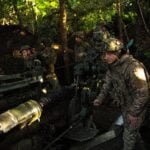There have been a string of highly unusual public disclosures about the Navy’s Ohio class nuclear ballistic missile submarines this year.
The U.S. military has made yet another unusual public announcement about the location and activities of one of the U.S. Navy’s 14 Ohio class nuclear missile submarines, or SSBNs. U.S. Strategic Command’s official statement today disclosed a visit by the USS West Virginia to the British island territory of Diego Garcia, which hosts major American military facilities, earlier this year.
This is the latest in a string of highly irregular public pronouncements in recent months regarding the movements of the Ohio SSBNs, as well as the four other boats in this class that were converted into guided missile submarines, or SSGNs, among other submarines. American officials have repeatedly stressed that these movements are part of routine operations. At the same time, it is difficult not to see these announcements as signals to potential adversaries or just general shows of force in the face of spikes in geopolitical friction in various parts of the world, such as Russia’s ongoing war in Ukraine, China’s actions toward Taiwan, and North Korea’s increasingly provocative ballistic missile tests.

U.S. Strategic Command (STRATCOM) said in a press release today that USS West Virginia had visited Diego Garcia, which lies in a remote part of the Indian Ocean, between October 25 and 31. The Ohio class SSBN made the stop as part of “an extended deterrence patrol providing security and stability to our Allies” that “emphasizes the unmatched capabilities of a ballistic missile submarine to deter and, if necessary, respond from anywhere on the globe,” according to STRATCOM.
Each Ohio SSBN, or ‘boomer,’ can be loaded with up to 20 Trident II submarine-launched ballistic missiles, also known as Trident D5s, each of which has a Multiple Independent Reentry Vehicle (MIRV) configuration and can be fitted with up to 14 nuclear warheads, which can include W76-1 and W88 types. The Navy’s boomers are understood to often carry fewer total missiles with reduced numbers of warheads due to obligations under arms control treaties with Russia. The service has also deployed some number of these missiles armed with W76-2 warheads, which are designed to have a lower yield than the W76-1 and are intended to offer a more “flexible deterrent,” as you can learn more about here.
The four Ohio SSGNs are conventional strike platforms that can be loaded with a maximum of 154 Tomahawk cruise missiles, but also typically carry fewer of those weapons to make space for other capabilities. These boats, which are among the most in-demand submarines in the Navy today, are actually highly capable multiple-purpose vessels that can serve as launch platforms for special operations forces and uncrewed systems, as well as underwater command and control and intelligence fusion centers, as The War Zone explored in depth in a previous feature.
Back in October, U.S. Central Command (CENTCOM) had made another rare decision to publicize West Virginia‘s presence in the Arabian Sea. While there, the submarine had hosted an at-sea visit by CENTCOM commander U.S. Army Gen. Michael Kurilla, as well as Navy Vice Adm. Brad Cooper, the commander U.S. Fifth Fleet and Naval Forces Central Command (NAVCENT), and members of these respective staffs.

Earlier this month, the Ohio class SSBN USS Rhode Island made a public visit to another British naval base, His Majesty’s Naval Base Gibraltar, at the western mouth of the Mediterranean Sea. The Navy had also announced that submarine’s stop at His Majesty’s Naval Base Clyde in Scotland in July, where there has been a pronounced uptick in British, American, and other allied submarine activity this year.

When it comes to Ohio SSGNs, last week, the Navy announced that the USS Michigan had sailed into port on the Japanese island of Okinawa on November 10. In January, ahead of Russia’s all-out invasion of Ukraine, USS Georgia had made a public port call in Cyprus in the Mediterranean.
Historically, the Navy, and other elements of the U.S. military, have been very tight-lipped about the activities of submarines, in general, which benefit heavily from their ability to conduct various types of operations discreetly around the world. Ohio SSBNs, especially, are intended to effectively disappear during their patrols to help ensure they can provide a credible second-strike deterrent capability and generally carry out those deployments with as little fanfare as possible.
“The stealth and response capability of these [Ohio class nuclear ballistic missile] submarines combined with the crew’s training make our SSBNs the most powerful warships in the world,” Navy Vice Adm. William Houston, the service’s top submarine officer, said himself in a statement accompanying the press release today about West Virginia‘s stop in Diego Garcia.
“Every operational plan rests on the assumption that nuclear deterrence is holding, and SSBNs like West Virginia are vital to a credible nuclear deterrence for the United States and our Allies,” Adm. Charles Richard, commander of U.S. Strategic Command, said in a separate statement.
As has been the case with early official disclosures about the activities of the Navy’s Ohio class, as a whole, it is not clear exactly what messages American officials might be intended to send with these disclosures. When it comes to West Virginia in Diego Garcia, this certainly highlights the presence of a boomer in a location that is equally relevant to Europe and Asia at a time when events in both regions present significant issues for U.S. national security and that of its allies and partners.

Beyond Russia’s conventional war in Ukraine, the country’s President Vladimir Putin and other Russian officials have threatened, or at least alluded to, the potential use of nuclear weapons in that conflict as Ukrainian forces have made steady advances in recent months. In October, Putin downplayed these fears, but concerns remain. Experts generally agree that there does not appear to be an imminent threat of this kind of escalation, as you can read more here.
Russian authorities have also baselessly accused their Ukrainian counterparts of preparing to set off a so-called “dirty bomb,” which is designed to spread dangerous radioactive material rather than result in a nuclear detonation, in recent months. This has prompted concerns that Russia might be preparing to stage some kind of radiological provocation as a pretext for further escalation, nuclear or otherwise.
Outside of Europe, there has also been an escalating series of North Korean missile launches, the most recent of which involved a massive intercontinental ballistic missile (ICBM) capable of reaching the United States. Many analysts fear this is a lead-up to Pyongyang conducting a new nuclear weapons test. A North Korean state media report over the weekend said that the country’s leader Kim Jong Un had declared an almost laughably ambitious goal for his nation to become the most powerful nuclear-armed state in the world. Kim also introduced his daughter, believed to be named Kim Ju Ae, to the world following the recent ICBM launch, prompting widespread speculation about her role in the country’s future.
This year has separately seen a dramatic spike in U.S. government friction with its Chinese counterparts over Taiwan. There are now significant protests in many major cities in China sparked by that country’s draconian restrictions in response to the ongoing COVID-19 pandemic. All of this comes amid discussions about whether a hot conflict between American and Chinese forces, over Taiwan or another flashpoint like disputes in the South China Sea, is increasingly inevitable, and concerns from STRATCOM’s Adm. Richard himself about whether America’s nuclear deterrent might hold in such a scenario.
Whatever the exact reason or reasons might be for announcing West Virginia‘s visit to Diego Garcia, as well as the other Ohio class-related disclosures this year, the U.S. military has been unusually keen to publicly highlight these submarine capabilities of late.
Source : The Drive












